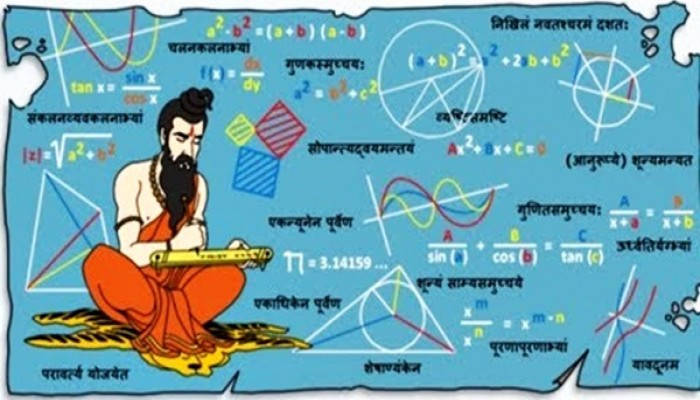Algebra Originated in India Part-3
- In Mathematics, Science & Technology
- 12:03 PM, Jul 17, 2021
- Chandrahas Halai
This article is in continuation of my earlier article:
https://myind.net/Home/viewArticle/algebra-originated-in-india
https://myind.net/Home/viewArticle/algebra-originated-in-india-part-2
In the year 1881, a farmer in the village of Bakhshali, some 80 kms from Peshawar, then in undivided India, was excavating soil. There he accidentally found 70 tattered pages of birch barks. These birch barks had important ancient Indian mathematical content which is now known as the Bakhshali Manuscript. They are presently kept in the Bodleian Library, Oxford. Carbon dating suggests that the birch barks are from 200 – 400 CE.
The earliest treatment of the systems of linear equations with several unknowns in India is to be found in the Bakhshali manuscripts.
Type I
Let us consider an interesting problem from Bakhshali manuscript:
Three persons each possess a certain amount of money. The capital of the first and the second together add to 13; the capital of the second and the third taken together add up to 14 and the cash of the first and third added together is 15. Tell me the amount of money with each of them?
Solution:
Though the method used in the Bakhshali manuscript is that of the false position, I will use the method that is used now so that it is easier for the general reader to understand it.
Let x1, x2 and x3 be the cash with the three persons respectively. Then, we have the following equations:

We will have to eliminate x2 and x3 from these equations. For that we will do the following operation:
(eqn 1) – (eqn 2) + (eqn 3)

Substituting the value of x1 in equations (1) and (3), we have
x2 = 6 and x3 = 8
In the above method to keep only one unknown and eliminate the others the number of variables need to be odd. In the Bakhshali manuscript also the problems of this kind only have odd number of unknowns.
This paragraph is for those who understand Linear Algebra:
If the variables are even in numbers and hence the number of equations, the rows in the system of linear equations are linearly dependent and thus the linear system will have infinitely many solutions
Let us consider one more problem of the same type from Bakhshali manuscripts.
Five persons each possess a certain amount of money. The capital of the first and the second together add to 16; the capital of the second and the third taken together add up to 17; the cash of the third and fourth added together is 18; the cash of the fourth and fifth added together is 19 and the cash of the fifth and first added together is 20. Tell me the amount of money with each of them?
Solution:
Let x1, x2, x3, x4 and x5 be the cash with the five persons respectively. Then, we have the following equations:

We will have to eliminate x2 and x3 from these equations. For that we will do the following operation:
(eqn 1) – (eqn 2) + (eqn 3) – (eqn 4) + (eqn 5)

Thus we now have
x2 = 7, x3 = 10, x4 = 8 and x5 = 11
Type II
वणिजस्ते चत्वारः पृथक् पृथक् शौल्किकेन परिपृष्टाः।
किं भाण्डसारमिति खलु तत्राहैको वणिक्च्छ्रेष्ठः॥१६०॥
आत्मधनं विनिगृह्य द्वाविंशतिरिति ततः परोऽवोचत्।
त्रिभिरुत्तरा तु विंशतिरथ चतुरधिकैव विंशतिस्तुर्यः॥१६१॥
सप्तोत्तरविंशतिरिति समानसारा निगृह्य सर्वेऽपि।
ऊचुः किं ब्रूहि सरवे पृथक् पृथग्भाण्डसारं मे॥१६२॥
Four merchants who had invested their money in common were each asked separately by the customs officer what the value of the commodity was. The first merchant, leaving out his own investment, stated that it was 22, the second stated it to be 23, the third 24 and the fourth 27; each of them deducted his own amount in the common investment. Tell me, O friend, separately the value of the commodity owned by each.
The above problem is from the book Ganitasarasangraha written around 850 CE by Digambara Jain monk Mahavira (815 – 877 CE).
Solution:
Let the amounts invested by each merchant in the common investment be x1, x2, x3 and x4 respectively.
Thus, we now have

Adding up all the above equations, we get

Thus, we now have from eqn 1


This problem can be generalised as

Adding up all the above equations we get

This method is given by Mahavir as a sutra in Ganitasarasangraha.
सर्वधनेष्टहीनशेषपिण्डात् स्वस्वहस्तगतदधनानयनसूत्रम् –
रुपोननरैर्विभजेत् पिण्डीकृतभाण्डसारमुपलब्धम्।
सर्वधनं स्यात्तस्मादुत्कविहीनं तु हस्तगतम्॥१५९॥
Meaning:
The stated amounts of the commodities added together should be divided by the number of men less one. The quotient will be the total value of all the commodities. When each of the stated amounts is subtracted from this total amount, the value in the hands of each will be found.
The above method was also explained by Aryabhatt (476-550 CE) in his work Aryabhatiya and by Narayana Pandit in Ganitakaumudi (1356 CE).
Image Source:myindiamyglory
Disclaimer: The opinions expressed within this article are the personal opinions of the author. MyIndMakers is not responsible for the accuracy, completeness, suitability, or validity of any information on this article. All information is provided on an as-is basis. The information, facts or opinions appearing in the article do not reflect the views of MyindMakers and it does not assume any responsibility or liability for the same.







Comments